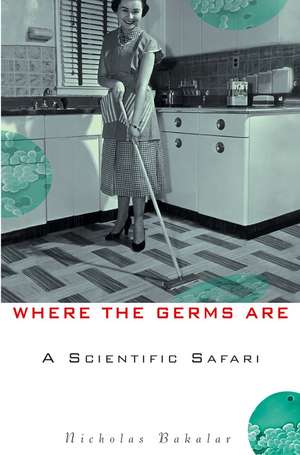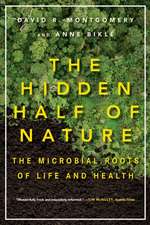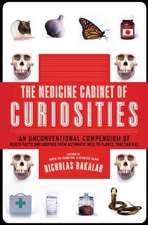Where the Germs Are: A Scientific Safari
Autor Nicholas Bakalaren Limba Engleză Hardback – 27 ian 2003
Germs are everywhere––in our intestines and on our skin as well as on kitchen counters, public toilets, doorknobs, and just about everything else. Why are there so many microorganisms? Which ones are dangerous? And how can we avoid the ones that will make us sick? This entertaining and informative book provides the answers. Profiling a rogue′s gallery of harmful germs––from the influenza virus, salmonella, and herpes to hepatitis, tuberculosis, and HIV––as well as helpful microbes (we actually need E. Coli and other bacteria for proper digestion), the book reveals how different germs interact with the human body and what happens when they do.
Nicholas Bakalar (New York, NY) is the author or coauthor of ten books, including Hepatitis A to G and Wiping Out Head Lice.
Preț: 220.83 lei
Nou
Puncte Express: 331
Preț estimativ în valută:
42.26€ • 45.89$ • 35.50£
42.26€ • 45.89$ • 35.50£
Carte disponibilă
Livrare economică 01-15 aprilie
Preluare comenzi: 021 569.72.76
Specificații
ISBN-13: 9780471155898
ISBN-10: 0471155896
Pagini: 272
Dimensiuni: 221 x 284 x 20 mm
Greutate: 0.91 kg
Editura: Wiley (TP)
Colecția John Wiley &Sons
Locul publicării:Hoboken, United States
ISBN-10: 0471155896
Pagini: 272
Dimensiuni: 221 x 284 x 20 mm
Greutate: 0.91 kg
Editura: Wiley (TP)
Colecția John Wiley &Sons
Locul publicării:Hoboken, United States
Public țintă
Pop science readers, germophobes and hypochondriacs.Descriere
"′Dirty! Don′t touch! Yuck! Feh! You don′t know where it′s been!′ These admonitions ring in our ears–for some of us our earliest memories of parental exhortation, for others the indelible mark of our deepest fears. Germs, as we know, are everywhere, lying in wait to attack the inadequately vigilant or insufficiently armed, gangs of serial killers on a random search for their next victim. We do not mock. Well, maybe we mock a little, but in fact, mother (or father) does sometimes know best–some germs can be very nasty invaders indeed. Yet we live in a world of microbes–some dreadful, some harmless, some essential to our continued life on earth. Knowing which to avoid, which to eliminate, and which just to live happily with can turn fearful warnings into reasoned discourse, and trembling terror into intelligent action."
––From the Preface
What do microbes have to do with your pets, your kids, your supermarket, your laundry, your sex life, your vacation at the beach, and your dinner plans for Saturday night? Plenty, as it turns out, and you′ll learn all about it in Where the Germs Are.
This doesn′t mean you have to panic, run out and buy every one of the more than 700 antibacterial products now on the market, dress in surgical scrubs, or live in a plastic bubble. In fact, most of the germs we live with are harmless, and some are positively delightful–like the ones that make grapes into wine, give yogurt its tang and cheeses their multitude of flavors, and lend sourdough bread its satisfying bite and aroma. But of course there are a nasty few that it would be good to avoid, and avoiding them means knowing something of the way they behave. Where the Germs Are is an intelligent, well–informed, scientifically accurate, and often delightfully funny guide to microbe country. Why not stop by for a spell–after all, you′re already there.
––From the Preface
What do microbes have to do with your pets, your kids, your supermarket, your laundry, your sex life, your vacation at the beach, and your dinner plans for Saturday night? Plenty, as it turns out, and you′ll learn all about it in Where the Germs Are.
This doesn′t mean you have to panic, run out and buy every one of the more than 700 antibacterial products now on the market, dress in surgical scrubs, or live in a plastic bubble. In fact, most of the germs we live with are harmless, and some are positively delightful–like the ones that make grapes into wine, give yogurt its tang and cheeses their multitude of flavors, and lend sourdough bread its satisfying bite and aroma. But of course there are a nasty few that it would be good to avoid, and avoiding them means knowing something of the way they behave. Where the Germs Are is an intelligent, well–informed, scientifically accurate, and often delightfully funny guide to microbe country. Why not stop by for a spell–after all, you′re already there.
Textul de pe ultima copertă
"′Dirty! Don′t touch! Yuck! Feh! You don′t know where it′s been!′ These admonitions ring in our ears–for some of us our earliest memories of parental exhortation, for others the indelible mark of our deepest fears. Germs, as we know, are everywhere, lying in wait to attack the inadequately vigilant or insufficiently armed, gangs of serial killers on a random search for their next victim. We do not mock. Well, maybe we mock a little, but in fact, mother (or father) does sometimes know best–some germs can be very nasty invaders indeed. Yet we live in a world of microbes–some dreadful, some harmless, some essential to our continued life on earth. Knowing which to avoid, which to eliminate, and which just to live happily with can turn fearful warnings into reasoned discourse, and trembling terror into intelligent action."
––From the Preface
What do microbes have to do with your pets, your kids, your supermarket, your laundry, your sex life, your vacation at the beach, and your dinner plans for Saturday night? Plenty, as it turns out, and you′ll learn all about it in Where the Germs Are.
This doesn′t mean you have to panic, run out and buy every one of the more than 700 antibacterial products now on the market, dress in surgical scrubs, or live in a plastic bubble. In fact, most of the germs we live with are harmless, and some are positively delightful–like the ones that make grapes into wine, give yogurt its tang and cheeses their multitude of flavors, and lend sourdough bread its satisfying bite and aroma. But of course there are a nasty few that it would be good to avoid, and avoiding them means knowing something of the way they behave. Where the Germs Are is an intelligent, well–informed, scientifically accurate, and often delightfully funny guide to microbe country. Why not stop by for a spell–after all, you′re already there.
––From the Preface
What do microbes have to do with your pets, your kids, your supermarket, your laundry, your sex life, your vacation at the beach, and your dinner plans for Saturday night? Plenty, as it turns out, and you′ll learn all about it in Where the Germs Are.
This doesn′t mean you have to panic, run out and buy every one of the more than 700 antibacterial products now on the market, dress in surgical scrubs, or live in a plastic bubble. In fact, most of the germs we live with are harmless, and some are positively delightful–like the ones that make grapes into wine, give yogurt its tang and cheeses their multitude of flavors, and lend sourdough bread its satisfying bite and aroma. But of course there are a nasty few that it would be good to avoid, and avoiding them means knowing something of the way they behave. Where the Germs Are is an intelligent, well–informed, scientifically accurate, and often delightfully funny guide to microbe country. Why not stop by for a spell–after all, you′re already there.
Cuprins
Preface.
Acknowledgments.
1. Microbes: An Introduction.
2. Hungry? Let′s Eat: The Contaminated Kitchen.
3. Toilet Training: Washing Hands Is the Best Revenge.
4. Whiter Whites and Brighter Colors: Healthy Laundry.
5. Clean Up That Room: Kids and Microbes.
6. What Love′s Got to Do with It: Microbes and Your Sex Life.
7. Wild Kingdom: Pets and Their Germs.
8. Up Your Nose: The Flu and the Cold.
9. Bottled or Tap: Water, and What′s in It.
10. Fresh Air and Sunshine: Outdoor Fun with Microbes.
11. Paint the Town Red: Germs in Public Places.
12. The Antiseptic Supermarket: Products That Do Something, Products That Do Nothing, and Products That Actually Do Harm.
Glossary.
Notes.
Index.
Acknowledgments.
1. Microbes: An Introduction.
2. Hungry? Let′s Eat: The Contaminated Kitchen.
3. Toilet Training: Washing Hands Is the Best Revenge.
4. Whiter Whites and Brighter Colors: Healthy Laundry.
5. Clean Up That Room: Kids and Microbes.
6. What Love′s Got to Do with It: Microbes and Your Sex Life.
7. Wild Kingdom: Pets and Their Germs.
8. Up Your Nose: The Flu and the Cold.
9. Bottled or Tap: Water, and What′s in It.
10. Fresh Air and Sunshine: Outdoor Fun with Microbes.
11. Paint the Town Red: Germs in Public Places.
12. The Antiseptic Supermarket: Products That Do Something, Products That Do Nothing, and Products That Actually Do Harm.
Glossary.
Notes.
Index.
Recenzii
In the last 12 months Americans have watched as germs made the headlines: anthrax, West Nile virus, bubonic plague and outbreaks of illness on cruise ships. Bakalar (Hepatitis A to G) explains where the enemy is lurking and how to defeat it. The most likely place to find bacteria? On, and in, your own body – but many of these are actually beneficial or at least benign. The kitchen is the main battleground in the home in the war against salmonella and campylobacter. Many foods come from the market carrying a battalion of germs, but Bakalar discusses the safest ways to chop, cook and clean up to minimize the risk. The bathroom is second as a home health hazard. Flushing the toilet actually aerosolizes water droplets (and germs), so put the seat and lid down, guys. Bakalar discusses potential health risks from pets: dogs are the safest, but you might want to think twice about iguanas and other reptiles. His excellent chapter on childhood diseases and vaccines should be required reading for parents, and teenagers should be plunked down in a chair with the chapter on sexually transmitted diseases. Bakalar doesn′t miss much: he overlooks histoplasmosis, a significant health problem in towns with birds roosting on downtown buildings, and he leaves out anthrax although he discusses smallpox. His writing is witty, and he gives all the details of germs and illnesses without medical school jargon. In short, according to this book, the best defense against germs is what your mother always told you: Wash your hands. Often. (Jan.) (Publishers Weekly, December 23, 2002)
"...His writing is witty, and he gives all the details of germs and illnesses without medical school jargon." (Publishers Weekly, December 23, 2002)
"...His writing is witty, and he gives all the details of germs and illnesses without medical school jargon." (Publishers Weekly, December 23, 2002)
Notă biografică
NICHOLAS BAKALAR is a New York–based writer and book editor. He is the author or coauthor of ten books, including Understanding Teenage Depression, Hepatitis A to G, Wiping Out Head Lice, and AIDS and People with Severe Mental Illness.






